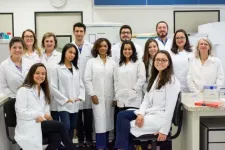(Press-News.org) The abundant presence of an enzyme known as low molecular weight protein tyrosine phosphatase (LMWPTP) in tumor cells has long been considered an indicator of cancer aggressiveness and metastatic potential. It is also known to perform important functions in cells under normal conditions, participating in both the proliferation process and the regulation of intracellular systems. Research continues on its role in cancer progression.
In Brazil, a group of researchers at the University of Campinas’s In Vitro Bioassay and Signal Transduction Laboratory led by Professor Carmen Veríssima Ferreira-Halder are studying the possibility of inhibiting this protein phosphatase to create novel opportunities for monitoring and treatment of cancer and other diseases.
“We believe inhibition of LMWPTP could contribute to the treatment of several diseases,” Ferreira-Halder said. “In our case, the focus is on cancer, but research shows it’s also associated with autoimmune diseases and diabetes, among others.”
Ferreira-Halder was principal investigator for the Thematic Project “Low molecular weight protein tyrosine phosphatase in colorectal cancer: from the bench to product generation”, supported by FAPESP and completed in June 2020.
The phosphatase favors the action of intratumor proteins that help tumors divide, migrate and establish metastasis. “For this reason we say it’s a ‘hub’, in the sense that it controls several processes which together make tumor cells resistant to treatment and able to migrate and establish metastasis,” she said.
A review article by the group published in Cellular and Molecular Life Sciences outlines 14 years of research on LMWPTP and its contribution to cancer treatment. “Our group was one of the first to show that this enzyme contributes to chemotherapy resistance in leukemia cells,” Ferreira-Halder said. “We also found that the more advanced the stage of the tumor, the larger the amount of the enzyme. With these discoveries as a basis, research conducted in collaboration with the group led by Professor Maikel Peppelenbosch at Erasmus University Medical Center in Rotterdam [Erasmus MC, Netherlands] validated the significance of LMWPTP to other types of cancer, such as prostate, colorectal and stomach cancer. This research showed us that LMWPTP not only weakens the response to chemotherapy drugs but is also associated with a greater capacity for metastasis.”
Druggable target
The review article, whose first author is Alessandra Valéria de Sousa Faria, also discusses the available substances that inhibit LMWPTP and the characteristics that make it difficult for drugs to be designed against it. Ferreira-Halder believes it is not yet possible to speak of treatment based on inhibition of LMWPTP, but the strategy can be used for other purposes.
“Our initial aim is to use this enzyme as a biomarker for the purpose of monitoring treatment, and also to use it to classify patients in terms of the severity of disease. In my view this can be done in a relatively short time,” she said. “As for treatment, a lot more work remains to be done. Professor Nunzio Bottini at the University of California San Diego [USA] has filed for a patent on a highly effective inhibitor that can be administered orally. Actually he and his group have synthesized several inhibitors, but they have only published one. Maybe we’re in for a surprise and a drug will be developed faster. Who knows?”
The main challenges to be faced in developing inhibitors are specificity – the drug must act specifically on LMWPTP, which is part of a family of some 100 highly similar phosphatases – and stability, so that the drug remains active in the organism. “Until Bottini and his group filed their patent application, all inhibitors acted on several members of the family,” Ferreira-Halder said.
Some of the substances mentioned in the review were developed for other purposes but also inhibit LMWPTP and could be used to treat cancer, according to Faria, who recently defended her doctoral thesis on how LMWPTP affects platelets, small cell fragments in the bloodstream that play a key role in clotting.
Platelets
Faria’s research on LMWPTP began with its role in colorectal cancer and platelet reaction in this microenvironment. “As our investigation of platelet biology progressed, we realized how much more knowledge of the enzyme’s action on platelets was needed,” she said.
The first part of the study consisted of verifying the action of LMWPTP and the protein tyrosine phosphatase 1B (PTP1B) on platelets, with regard to both metabolism and function. The second focused on the influence of platelets on the expression of LMWPTP in cells.
“The goal was to find out to what extent tumor cells may ‘educate’ platelets to support certain events, such as metastasis, for example, and conversely how far platelets ‘educate’ tumor cells to assure their survival and proliferation,” Faria explained.
For Ferreira-Halder, the relationship appears to be two-way. “However, the action of tumor cells probably predominates. They practically program platelets to work in their favor,” she said.
Collaborations
Ferreira-Halder and her group have collaborated with Peppelenbosch’s since 2004, but work on the Thematic Project completed in June began only 2016, she recalled, adding that experiments conducted by Emanuella Maria Barreto Fonseca and Cláudia de Lourdes Soraggi at Peppelenbosch’s laboratory provided a vitally important foundation for the initial hypotheses. Fonseca was supported by a postdoctoral fellowship from FAPESP. Soraggi was able to attend an overseas training course thanks to support from the University of Campinas (UNICAMP) via its Executive Vice Rectorship for International Relations.
“In our Thematic Project research, we were able to investigate the action of this phosphatase from various angles and validate the hypothesis of its role in other tumors besides chronic myeloid leukemia,” Ferreira-Halder said. “We wanted to uncover the mechanism of its action, and we now have a great deal of information about this action – not just inside but also outside the tumor, because we set out to see if LMWPTP also influenced the tumor’s microenvironment external to the cancer cells.”
Other research interests for the group during the project included: extracellular vesicles (nanometer-sized structures that play an important role in intercellular communication), with Stefano Piatto Clerici supported by FAPESP showing that LMWPTP regulates these vesicles; platelets, studied by Faria, also with a scholarship from FAPESP; and the TGF-beta signaling pathway, which is involved in many cellular processes such as proliferation and differentiation and was studied by Helon Guimarães Cordeiro.
The network of collaborators continued to expand, adding an expert in platelet biology (Sheila Siqueira Andrade at PlateInnove Biotech), and a hematologist and an oncologist at Erasmus MC (Moniek de Maat and Gwenny Fuhler respectively).
According to Ferreira-Halder, the Thematic Project has so far spawned 15 publications (eight articles and two book chapters, as well as five articles under peer review), and several other research fronts. A new project in the same line of research is currently being designed.
Scientists study use of abundant enzyme in tumor cells to monitor cancer treatment
After 14 years studying the action of the enzyme LMWPTP in tumor cells, Brazilian researchers conclude that the molecule is associated with chemotherapy resistance and metastasis.
2021-01-12
ELSE PRESS RELEASES FROM THIS DATE:
Formula predicts ideal dose of stem cells to cure HIV
2021-01-12
Scientists have determined the optimal conditions following a stem cell transplant that could control HIV without the need of an everyday pill, according to a study published today in eLife.
Finding the right balance of stem cell dose, cell type and timing of antiretroviral therapy (ART) could potentially lead to a spontaneous cure of HIV.
There are only two cases of HIV cure to date: the Berlin Patient and the London Patient, who both received stem cell transplants with stem cells from donors that lack a molecule called CCR5, which HIV is attracted to.
"The major obstacle to HIV eradication is a latent reservoir of long-lived infected cells, and cure strategies aim to eliminate all infected cells or permanently prevent viral reactivation ...
Study identifies immune response biomarkers, novel pathways in four marine mollusc species
2021-01-12
Understanding the immune systems of oysters and clams is important in monitoring the effects of pollution and climate change on the health of molluscan species and the potential impacts on the aquaculture industry. Their immune responses also can serve as indicators of changes in ocean environments.
A new study involving the University of Maine assessed immune responses in four economically important marine mollusc species -- the blue mussel, soft-shell clam, Eastern oyster, and Atlantic jackknife clam -- and identified new biomarkers relating to changes ...
Discovery of a new approach to inhibiting a highly treatment-refractory liver cancer
2021-01-12
BOSTON -- Reprogramming the rich connective tissue microenvironment of a liver cancer known as intrahepatic cholangiocarcinoma (ICC) inhibits its progression and resistance to standard chemotherapy in animal models, researchers from Massachusetts General Hospital (MGH) have found. This new treatment for a disease with extremely poor outcomes uses antibodies to block placental growth factor (PlGF), a member of the vascular endothelial growth factor (VEGF) family, which has been widely studied for its role in new vessel formation in cancers. PlGF is highly expressed ...
UCF researchers use advanced light to reveal how different biofuels behave
2021-01-12
ORLANDO, Jan. 12, 2021 -Vehicles have evolved to become more efficient and sophisticated, but their fuel hasn't necessarily evolved along with them. The Department of Energy is determined to identify cleaner burning and renewable alternatives to gasoline, and through the work of two UCF researchers, the DOE is one step closer to that goal.
Research engineer Anthony C. Terracciano and Associate Professor Subith Vasu have developed a model that will help engine designers, fuel chemists and federal agencies determine whether certain biofuels should be implemented as an alternative fuel ...
How many tests after vasectomy? Guideline update leads to change in practice
2021-01-12
January 12, 2021 - A change in evidence-based guidelines for vasectomy may have led to a reduction in the number of follow-up tests to confirm the procedure was successful, reports a study in Urology Practice®, an Official Journal of the American Urological Association (AUA). The journal is published in the Lippincott portfolio by Wolters Kluwer.
Originally published in 2012, and then updated in 2015, the AUA clinical guideline could significantly reduce the number of men undergoing multiple postvasectomy semen analyses (PVSAs) to confirm it's safe to stop using other methods of birth control, according to new research by Tony Chen, MD, of University of Washington, ...
Soil degradation costs U.S. corn farmers a half-billion dollars every year
2021-01-12
One-third of the fertilizer applied to grow corn in the U.S. each year simply compensates for the ongoing loss of soil fertility, leading to more than a half-billion dollars in extra costs to U.S. farmers every year, finds new research from the University of Colorado Boulder published last month in Earth's Future.
Long-term soil fertility is on the decline in agricultural lands around the world due to salinization, acidification, erosion and the loss of important nutrients in the soil such as nitrogen and phosphorus. Corn farmers in the U.S. offset these losses with nitrogen and ...
Enlightening dark ions
2021-01-12
Every field has its underlying principles. For economics it's the rational actor; biology has the theory of evolution; modern geology rests on the bedrock of plate tectonics.
Physics has conservation laws and symmetries. For instance, the law of conservation of energy - which holds that energy can neither be created nor destroyed -- has guided research in physics since antiquity, becoming more formalized as time went on. Likewise, parity symmetry suggests that switching an event for its mirror image shouldn't affect the outcome.
As physicists have worked to understand the truly bizarre rules ...
Study of flowers with two types of anthers solves mystery that baffled Darwin
2021-01-12
Most flowering plants depend on pollinators such as bees to transfer pollen from the male anthers of one flower to the female stigma of another flower, enabling fertilization and the production of fruits and seeds. Bee pollination, however, involves an inherent conflict of interest, because bees are only interested in pollen as a food source.
"The bee and the plant have different goals, so plants have evolved ways to optimize the behavior of bees to maximize the transfer of pollen between flowers," explained Kathleen Kay, associate professor of ecology ...
High doses of saccharin don't lead to diabetes in healthy adults, study finds
2021-01-12
COLUMBUS, Ohio - For those trying to live a healthy lifestyle, the choice between sugar and artificial sweeteners such as saccharin can be confusing. A new study led by researchers at The Ohio State University Wexner Medical Center and The Ohio State University College of Medicine found the sugar substitute saccharin doesn't lead to the development of diabetes in healthy adults as previous studies have suggested.
The study findings are published in the journal Microbiome.
"It's not that the findings of previous studies are wrong, they just didn't adequately control for things like ...
Scientists identify "immune cop" that detects SARS-CoV-2
2021-01-12
LA JOLLA, CALIF. - Jan 12, 2020 - Scientists at Sanford Burnham Prebys Medical Discovery Institute have identified the sensor in human lungs that detects SARS-CoV-2 and signals that it's time to mount an antiviral response. The study, published today in Cell Reports, provides insights into the molecular basis of severe disease and may enable new strategies for the treatment and prevention of COVID-19.
"Our research has shown that MDA-5 is the immune cop that's tasked to keep an eye out for SARS-CoV-2 and call for back-up," says Sumit Chanda, Ph.D., director of the Immunity and Pathogenesis Program at Sanford Burnham Prebys and senior author of ...
LAST 30 PRESS RELEASES:
58% of patients affected by 2022 mpox outbreak report lasting physical symptoms
Golden Gate method enables rapid, fully-synthetic engineering of therapeutically relevant bacteriophages
Polar weather on Jupiter and Saturn hints at the planets’ interior details
Socio-environmental movements: key global guardians of biodiversity amid rising violence
Global warming and CO2 emissions 56 million years ago resulted in massive forest fires and soil erosion
Hidden order in quantum chaos: the pseudogap
Exploring why adapting to the environment is more difficult as people age
Society for Laboratory Automation and Screening welcomes new scientific director: Madeline M. Farley, Ph.D.
Austrian cow shows first case of flexible, multi-purpose tool use in cattle
Human nasal passages defend against the common cold and help determine how sick we get
Research alert: Spreading drug costs over the year may ease financial burden for Medicare cancer patients
Hospital partnership improves follow up scans, decreases long term risk after aortic repair
Layered hydrogen silicane for safe, lightweight, and energy-efficient hydrogen carrier
Observing positronium beam as a quantum matter wave for the first time
IEEE study investigates the effects of pointing error on quantum key distribution systems
Analyzing submerged fault structures to predict future earthquakes in Türkiye
Quantum ‘alchemy’ made feasible with excitons
‘Revoice’ device gives stroke patients their voice back
USF-led study: AI helps reveal global surge in floating algae
New method predicts asthma attacks up to five years in advance
Researchers publish first ever structural engineering manual for bamboo
National poll: Less than half of parents say swearing is never OK for kids
Decades of suffering: Long-term mental health outcomes of Kurdish chemical gas attacks
Interactional dynamics of self-assessment and advice in peer reflection on microteaching
When aging affects the young: Revealing the weight of caregiving on teenagers
Can Canada’s health systems handle increased demand during FIFA World Cup?
Autistic and non-autistic faces may “speak a different language” when expressing emotion
No clear evidence that cannabis-based medicines relieve chronic nerve pain
Pioneering second-order nonlinear vibrational nanoscopy for interfacial molecular systems beyond the diffraction limit
Bottleneck in hydrogen distribution jeopardises billions in clean energy
[Press-News.org] Scientists study use of abundant enzyme in tumor cells to monitor cancer treatmentAfter 14 years studying the action of the enzyme LMWPTP in tumor cells, Brazilian researchers conclude that the molecule is associated with chemotherapy resistance and metastasis.



